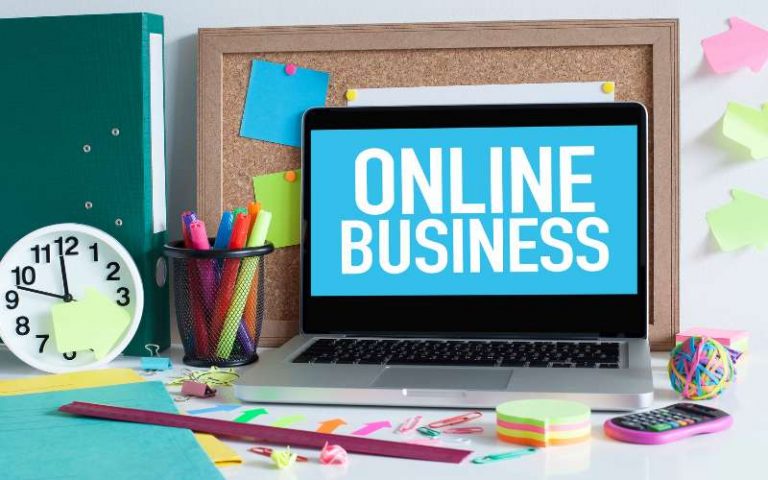

how to start a business online
Regardless of whether you’re setting up new operations, or working on a small-scale business, or working to get your accounting straightened out, WAG Consulting has all the online Accounting support that you need
How to start a business online.
Historically, only the fortunate few were permitted to establish their businesses. Starting capital was needed, and outside funding was scarce (unless you were born into a commerce-savvy family).
To be sure, that is no longer the case in 2021. Today, anyone, regardless of their professional background or prior entrepreneurial experience, can start and scale an online company.
Although the entry barrier has decreased, it has not been eliminated. You must also develop a viable product concept and sourcing or production plan and a sales model.
However, none of the above should dissuade you from starting an online company!

Justifications for Starting an Online Business
You may be thinking that why you should start an online business at all.
Why not go for a brick-and-mortar establishment instead?
Because there are many benefits to starting an online company.
The following are the three primary ones:
1. It is a relatively inexpensive way to get started.
Many people want to start a business but are discouraged by the investment needed to get it started. You must pay for a mortgage, inventory, and employee salaries. What happens if you spend all of that money in your company and it fails? This can be financially disastrous.
However, with an online company, all that is required is the following:
Personal computer. You almost certainly do have one.
The domain’s name. One is available for less than INR 500 a year.
Website creator: Monthly plans begin at INR 999 per month.
In other words, it is possible to open an online company with a capital investment of INR 25,000-30,000
Naturally, the more money you have to invest at the outset, the more online business ideas you will try.
However, the point is that you do not have to sacrifice your entire life savings to succeed as an online entrepreneur.
2. Significant capacity and development.
When operating a brick-and-mortar company, you must contend with the constraints imposed by the “real world.”
Renting in prime places is costly, there might not be enough foot traffic on some days, and the local crowd does not need items constantly.
However, guess what? None of these restrictions apply if you operate an online company. You can sell to anyone, regardless of their location.
And as each year passes, the pool of potential customers grows more prominent as more people become familiar with the concept of online dealings and purchases. By 2023, eCommerce is estimated to account for 22% of all retail transactions worldwide.
Additionally, the global Internet population is increasing. For example, the number of Internet users in North America alone increased by 73.3 million people between 2009 and 2020.
However, this is not important in comparison to the regions that are still emerging!
The number of Internet users in Asia increased from 764.4 million to 2.5 billion, representing an increase of 1.76 billion people.
There are more users online, which means that your online brand has a greater chance of visibility, especially if you’re not opposed to expanding your online business across the border.
3. Can operate 24 hours a day.
Additionally, online companies have an advantage over brick-and-mortar businesses in that they can operate 24 hours a day (even though lockdowns and other disruptions).
Once your online business website is up and running, you are constantly available to make a sale. Customers can place orders with you at any time.
Because you are not required to be physically present to make a transaction, your company can produce sales with less engagement on a day-to-day basis.
Five Online Business Models to Consider
With so many business opportunities and a plethora of ultimate guides available, deciding which one to follow can be difficult. It’s understandable, as you don’t want to take on too much risk.
We conducted some research with your assistance and whittled it down to only five online business ideas.
1. Create an online store.
While eCommerce has existed for nearly four decades, there has never been a better time to start an online store than right now.
According to the study “The Future of Retail 2019,” a third of US customers (32% ) now receive at least one Amazon shipment every week. Meanwhile, 10% of customers receive three or more packages from Amazon per week.
It’s probably fair to conclude that this increased focus on Amazon also contributes to increased trust in online shopping in general.
According to the same survey, 46% of customers are more receptive to buying a large-ticket item online than they were a year earlier.
After you’ve determined your product categories, you’ll need to choose an eCommerce platform (BigCommerce, Shopify, or WooCommerce, for example), set up your online store, and begin driving traffic to it. Alternatively, you might start selling on online marketplaces like Amazon, eBay, or Etsy.
Although e-commerce offers all three of the previously mentioned online business advantages, you should bear in mind that online commerce margins can be slim for some types of items.
2. Join the world of dropshipping.
Dropshipping is a form of online fulfillment that enables you to sell physical products without maintaining your inventory.
How it operates is as follows:
On your eCommerce website, the customer places an order for a product.
You notify the manufacturer of the order.
After that, the manufacturer ships the item directly to the consumer.
Dropshipping is an appealing choice for those interested in entering eCommerce without taking on the financial burden associated with inventory management. Therefore, it’s unsurprising that the dropshipping market is increasing! Revenues are expected to reach $557.9 billion in 2025.
Though drop shipping is appealing, it does have some drawbacks. These include low-profit margins, slow delivery speeds, and a lack of supply chain management, to name a few.
3. Become a member of the affiliate program.
Affiliate marketing is a viable option if you’re interested in starting an online company but aren’t interested in developing your products.
It’s a standard method of earning money online. According to SaaS Scout, brands spend an estimated $12 billion on affiliate marketing per year. The figure is projected to increase by 10% in the coming years.
Affiliate marketing operates as follows:
To begin, join an affiliate program.
Then, choose a product from another vendor to sell to your audience. This could be a digital product (an ebook, an online course, an app, or something else entirely) or a physical product.
You are then compensated for each sale produced through your referral connection.
You can advertise affiliate products on your blog by developing SEO content around related keywords and then optimizing it to attract organic Google traffic. Alternatively, you can promote affiliate items via social media.
When done correctly, affiliate marketing can be highly lucrative. Adam Energy, for example, earned $812,718 in 2020. Affiliate marketing produced $601,698 in passive income.
You can also use your e-mail list subscribers to advertise affiliate goods by allowing your affiliate partners to host webinars for your audience.
Affiliate marketing is a perfect business model with a meager entry cost. You would only be required to pay for a domain name, web hosting, and e-mail marketing services upfront.
Effective online businesses that begin by selling affiliate products often expand to offer their products. That way, you can earn significantly more money from the same amount of traffic.
4. Have web development services.
You can learn the fundamentals of web design through online courses and experimentation. Then, to begin attracting clients, build a portfolio website. Alternatively, create an account with a freelance platform such as Upwork or 99Designs. By the way, you don’t have to work as a freelancer full-time; you can do web design as a side hustle.
However, freelancing can be challenging at times. Although location independence and a flexible schedule are advantages, you will initially have a less stable income and financial stability. Therefore, create an emergency fund before going all-in.
Having said that, once you’ve mastered web design, you can branch out into making and selling your stuff (e.g., WordPress templates). This will assist in reducing financial uncertainty.
5. Create an attention-grabbing blog.
Blogging could be a worthwhile online business venture to consider.
While maintaining a blog does not constitute a business model in itself, it does allow you to create an audience.
If you’ve built an audience, you can sell your goods or services, endorse affiliate products, and partner with brands to run sponsored campaigns. Additionally, famous bloggers land speaking engagements and book deals.
How to Launch an Online Business in Ten Easy Steps
After settling on a business model, let’s take a closer look at the operational aspects of starting an online business. The following is a step-by-step overview:
Establish your niche and business concept.
Conduct market research on products.
Learn about the laws governing online businesses.
Conduct a business analysis.
Identify your intended audience.
Procure items to sell online.
Evaluate the feasibility of the commodity.
Create a brand and an image for your company.
Establish an online shop.
Expand your enterprise.
Decide on a Niche and a Business Concept
A business niche is a term that refers to your “focus field” — the market segment and target audience to which you cater primarily. This category includes athletes (e.g., gymnasts), hobbyists (e.g., post stamp collectors), and professionals (e.g., software developers).
It would be good if you chose a niche for your new venture. How do you locate a reputable one? Ascertain that your intended audience possesses the following:
An issue that no one else is adequately resolving.
Willingness to pay for resolving the problem.
Sufficient disposable income to cover the cost of the solution.
Avoid niches that do not follow all three of the above requirements. Since starting an online company is difficult enough. When you pursue customers who do not need your goods, cannot afford them or are uninterested, you compound your difficulties.
Conduct Market Research on Products
There are three primary forms of eCommerce goods that you can sell online. Each has its own set of advantages and disadvantages.
1. Tangible goods.
As the name suggests, these are physical products that must be manufactured, warehoused, and distributed to consumers. Although selling physical effects can be lucrative, profit margins can be slim if overhead costs are not well managed.
2. Downloads in digital format.
Additionally, you can sell digital goods — something that a customer can download to their smartphone, for example,
eBooks, audio classes, and online courses are all examples of this.
Profit margins on digital items are higher (compared to physical goods). However, pricing them can be challenging since they are often considered lower than material goods.
3. Professional services.
Virtually any service that is remotely accessible can be offered online. The quickest way to start an online company is to sell services (and turning a profit). However, this is a business model in which you sell your time. This means that your earning ability is reduced since each day has a fixed number of hours. That is unless you grow to the size of an organization.
Acquaint Yourself With Online Business Laws
Small business owners may believe that they are exempt from conventional business laws because they operate an online business. That is not the case.
Although operating an online company needs fewer licenses and permits than a brick-and-mortar operation, you must also address some critical legal issues. More precisely:
What type of business license (if any) are you need to operate?
Which legal structure (sole proprietorship, limited liability company, or corporation) makes the most sense?
Do you need any permits?
Are you required to pass any inspections?
Are you required to obtain a sales tax license?
Are there any laws that apply only to online businesses?
What rules govern the employment of contractors and employees?
Learn more about the laws and regulations governing online businesses and eCommerce businesses.
Nota bene: Each state and nation have their own set of rules. Ensure that all information is checked with local authorities. Additionally, if you can afford it, obtain competent legal assistance.
Market Research
Conducting online market research enables you to ascertain what your target audience desires, needs, or lacks.
Market research is the first step in launching your own online company. It assists in determining the vertical’s depth, competitiveness, and profitability. Lastly, establish a bid that nobody wants to purchase—additionally, market research assists in invalidating the product’s concept, pricing, and demand.
Here’s how to begin conducting market research:
1. Search the SERPs.
Analyze the search engine result pages (SERPs) for combinations of your product/service keywords. What kind of content currently ranks on the first page of search results? Which companies are paying to have their advertisements appear above organic search results?
This will assist you in pre-evaluating the competition. Additionally, gather data for a preliminary SEO and digital marketing plan focused on the content preferences of your target audience.
2. Conduct competitor research.
Additionally, you should conduct a thorough examination of your primary competitors (beyond SERPs). What are the most successful business projects in your industry? How much revenue do they generate? What are their advantages and disadvantages?
By examining other players, you can determine what could offer you a competitive advantage over them.
3. Maintain a list of high-performing keywords.
By tracking niche-relevant keywords, you will determine how demand for various products changes in your niche and what content performs best.
The following are practical tools for this:
- Trends on Google (free)
- Google’s Keyword Tool (free)
- refs (paid)
- The Semrush (paid)
- Create a Persona for Your Target Audience
- To generate sales and then scale your company, you must have a firm grasp of who your target audience is. Conduct demographic and psychographic analysis to ascertain their needs and desires.
1. Demographic information.
Demographic information encompasses fundamental socioeconomic characteristics such as age, gender, ethnic origin, salary, and job title.
2. Psychographic details.
Psychographic data refers to a range of psychological traits, including values, beliefs, desires, and opinions.
When combined, these observations assist in the development of a comprehensive understanding of your ideal buyer’s desires, expectations, and buying triggers.
Locate Items to Sell Online
You cannot operate a profitable online company if the goods are mediocre. And you’ll then find yourself on social media’s trending pages…for all the wrong reasons. As a result, devote more time to analyzing your product procurement approach.
1. Produce your goods.
This is a reasonably simple choice if you want to sell digital goods. However, producing physical products requires a great deal of effort in design, interaction, and material selection. Additionally, the financial costs are higher. However, manufacturing will still offer you an edge over the competition in pricing, product selection, and brand recognition.
2. Look for a drop shipper.
You may locate a producer who makes dropshipping. Numerous small business owners sign drop shipping agreements with foreign producers (primarily in Asia) to cover business expenses.
3. Associating with a wholesaler.
Alternatively, it would help if you located a wholesaler who will supply you with various items to buy and curate for your online store. Additionally, you will discover a wholesaler who will sell your goods for you (if you plan to manufacture them).
Assess the Product's Viability
You want to conduct a holistic evaluation of the feasibility of your product(s) before buying or producing a large order. To do so, consider the following:
Is there already a profitable online company selling similar products?
Is there a sustainable market for this product? Or is it a one-time thing?
Is the mathematics behind this product logical? Are you able to resell it profitably?
Bear in mind that it makes no difference how cool the product appears. What matters is that it is commercially viable!
Establish Your Brand's and Image
A brand is the business’s overall “vibe.” From your brand name to your web design and copy, you want it to convey a clear visual picture and message. The same is true for your off-site presence, including social media, your e-mail newsletter, and even your packaging.
When you focus on your brand identity, keep the following in mind:
- Logotype.
- Color palette.
- Layouts of pages.
- Typefaces.
- Illustrations and photographs.
Your brand picture should be the product of all of these components interacting.
Establish an Online Store
Preparation for launch is the next step in the business plan. This includes the installation and configuration of your eCommerce website.
1. Decide on an e-commerce platform.
An eCommerce platform serves as the strategic foundation for online commerce. This type of program includes all of the necessary features, from a product catalog to payment processing.
Several common choices include the following:
MassiveCommerce. An open-source SaaS platform provides a broad range of native commerce features while allowing unlimited extension and customization. Compared to Shopify, the out-of-the-box features of BigCommerce will save merchants approximately $5,800 – $30,000+ a year in-app subscription costs.
WordPress e-commerce platform. An open-source framework that you can customize to create any kind of store you want.
WooCommerce offers hundreds of extensions that help with delivery, payroll, and marketing, among other things. However, you’ll need to buy separate hosting and pay a developer to set up and design your shop.
Shopify.com. Shopify is a software-as-a-service platform that includes a robust set of native features and over 4,100 integrated applications (separate subscription fees apply). Additionally, it comes with over 70 professional and sensitive themes for building your website.
Choose a platform that offers all of the functionality you want at an affordable price.
2. Incorporate your goods.
After selecting a platform and a theme for your store, begin adding items to your catalog. As you, pay particular attention to the following:
Images of the items. Provide high-definition visuals of the product from various angles. For additional details, consult this guide to eCommerce photography.
Descriptions of products. Arrange features in no particular order — instead, prioritize the benefits that the consumer will get. This post contains a concise formula for writing.
3. Determine your shipping method.
Fast and free delivery is the primary reason people make online purchases (and has been for six consecutive years!).
Ascertain that all goods reach your consumers on time. Variety of shipping strategies:
- LTL freight carriers available for in-store pickup
- Delivery on the same day or the next day
- Shipping is complimentary.
4. Ascertain that it works properly.
Finally, once your eCommerce store is up and running, triple-test every aspect. Ascertain that:
All pages look great on all computers (desktop, tablet, mobile).
The website is compatible with a variety of browsers (Chrome, Brave, Firefox, etc.).
Each button is clickable and connects to the appropriate app.
If you have a budget, hire a quality assurance consultant to conduct the test and report on the results.
Expand The Enterprise
After you’ve completed the setup, it’s time to begin driving traffic to your eCommerce shop. Prioritize the channels mentioned below:
Advertisements that are not free. Budget for PPC (pay-per-click) advertisements on social media and in search results. That is the most efficient method of increasing brand recognition for a new store.
Marketing via influencers. Collaborate with social media influencers to spread the word about your goods. This is another effective method of bringing them to the attention of the target audience.
Marketing via social media. By growing audiences on Instagram and Facebook, you can supplement paid promotions with organic traffic.
Optimization of search engines (SEO). Ascertain that all of the website’s pages are designed for search engines. Then, develop a plan for your blog’s content marketing.
Marketing via e-mail. Create an e-mail list by collecting the e-mail addresses of visitors to your eCommerce shop. You can then use your e-mail subscribers to advertise your items.
Effective Online Businesses to Study
One of the most powerful ways to “learn” eCommerce is to analyze how other eCommerce companies got today.
Three “success stories” that you can reverse-engineer are mentioned below.
1. Online furniture sales.
When the Burrow co-founders were in business school, they faced a dilemma: should they purchase inexpensive yet disposable furniture, or should they buy proper furniture and risk waiting up to 12 weeks for it?
They recognized this as an opportunity for the company. What if they could streamline the online furniture purchasing process? That is how the concept of modular furniture was conceived. Kabeer and Stephen’s vision was well-received by their intended audience.
It’s an excellent illustration of how commonplace annoyances sometimes mask lucrative business opportunities!
2. Online t-shirt sales.
The Mountain, source
In the early 1970s, two New Jersey mates relocated to New Hampshire. Their dream was to sell belts and buckles at fairs and festivals in their communities. Due to the popularity of their products, they opened a retail store named “The Mountain.”
The Mountain has since expanded to 30 retail outlets in the mid-Atlantic states, in addition to a flourishing online store. Additionally, the retailer developed a niche for hand-dyed and printed t-shirts. Interestingly, they are a business best known for creating the most famous t-shirt in internet history.
It’s an uplifting tale that demonstrates how you can earn money by selling things you believe in.
3. Online candy sales.
Lammes Candies
The same family has owned Lammes Candies since 1885. As implied by the brand, the company offers a variety of confectionery items. Interestingly, their Pecan Pralines recipe has remained unchanged since 1892 (and it is still a closely guarded secret!).
Despite having a long history, Lammes Candies recognized the promise of eCommerce in 1992. They launched a static website featuring their product collection the following year and have been selling online ever since.
Lammes Candies teaches an important lesson: you must stay current with technology to remain competitive!
Finally,
Getting started with an online company does not have to be intimidating. Take should move cautiously. To begin, research an eCommerce niche and popular products. Following that, develop a business model and fulfillment plan.
Following that, begin setting up your online company. Select an eCommerce site, customize its interface, and populate your catalog with products. Concentrate your efforts on increasing traffic to your online store.
Once your company is operational, ensure that you obtain as much data as possible. Then evaluate the data to gain a complete understanding of what works and what does not. Appropriately adjust your market plan.
And don’t worry if you’re not an expert on eCommerce. None of us do. We are all gaining knowledge as we go!
Frequently Asked Questions About Starting an Online Business.
Question: What is the best form of online business to start?
Answer: Your professional experience and personal preferences determine it. Popular choices include online service-based businesses (as a natural progression from a freelance side hustle) and online product-based businesses, such as online stores. Both require little initial capital and can be scaled efficiently over time.
Question: Which online Business is the best to start from home?
Answer: Online service businesses, digital product businesses, and dropshipping businesses are the three best online businesses to start from home. Both can be easily managed from a home office with little or no additional equipment or space investment.
Question: What is the best way to start a small online business?
Answer: To begin a small online company, you must first decide the type of business you want to start — B2B or B2C, services or goods. Then, create a website. A simple one can be built for less than $100 using a SaaS website builder (no coding skills required). Add content, photos, and items to your website, add a payment system, and begin selling.
Question: What is the most profitable form of online business?
Answer: E-commerce is one of the most profitable online business models due to its infinite scalability. You can begin with a small niche store and expand it into a cross-country or even cross-border operation that services customers worldwide.
Question: What products are available for sale online?
Answer: Today, nearly every form of product can be sold online, as long as there is a market for it. To ascertain the feasibility of a product, assess the target market size (the approximate number of people who would want to purchase from you) and potential profit margins (the amount of money you can earn from selling a product for a price that the target market is ready to pay).
Question: Is it possible to start an online business without any money?
Answer: Technically, you can begin an online business without investing any money. However, a few small startup costs will remain, including a domain name (under $10), a website builder/platform (under $30/mo), and website content production. If you create and configure your business website on your own, you can start an online business without spending a fortune.
Question: Do you need marketing assistance with the launch of your business?
Answer: Although you do not need “marketing” as a business feature to launch an online business, you may need to invest in some promotional activities during the launch period unless you’re releasing to a previously acquired audience (e.g., your existing fans on social media or blog readers). A well-executed launch marketing strategy will pay for itself within hours.
Question: Is dropshipping a viable online business opportunity?
Answer: Dropshipping is an excellent online business model for new entrepreneurs who do not wish to invest in inventory or manage logistics. A dropshipping partner takes care of those two activities, allowing you to concentrate on marketing and brand growth. The disadvantage is that profit margins are often smaller with dropshipping, and differentiating your goods from the competition is more complicated.
Question: How do you come up with eCommerce market concepts?
Answer: The best eCommerce product innovations emerge from established industries, where either digital commerce penetration is still low (due to the competition selling mostly offline) or current product(s) do not entirely fulfill consumer needs. The demand for reusable water bottles is enormous, and interest in them is extremely high. However, only one company offers a self-cleaning water bottle that most people find more convenient than standard (and less expensive) water bottles.
Question: Do you want a business plan for your online venture?
Answer: Without a doubt! Establishing an online company is akin to driving without a rearview mirror: you’ll get where you’re going but can miss a massive obstacle in your path. While a formal, business school-style plan is not required for a small eCommerce business, it is recommended that you create at least a brief roadmap document outlining your primary steps before launch.


